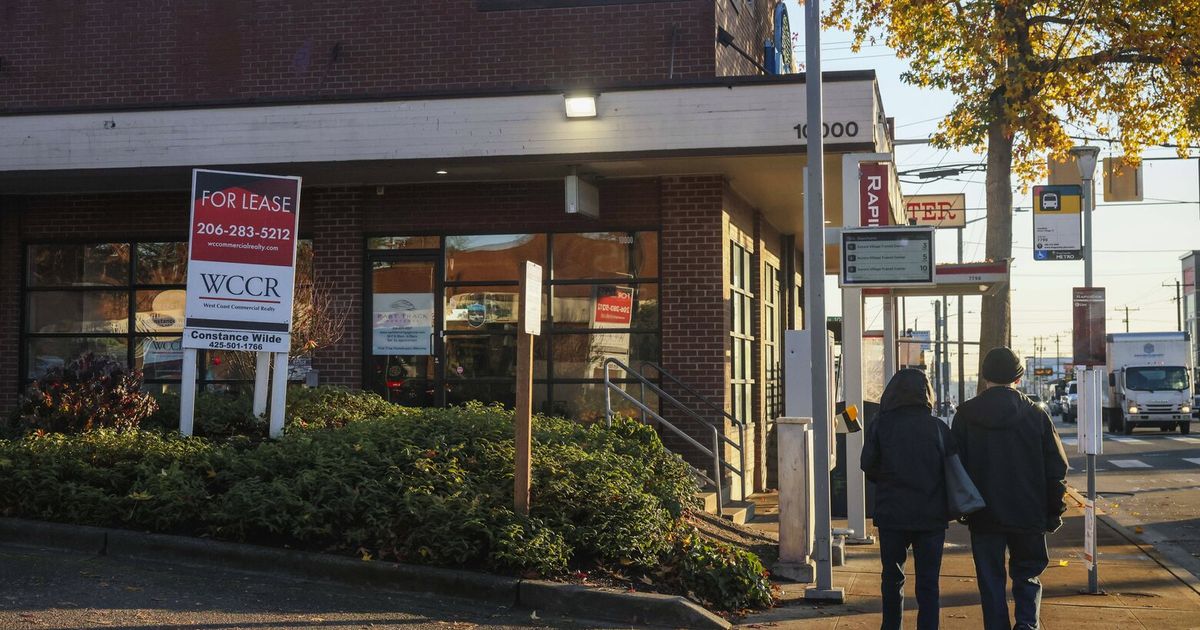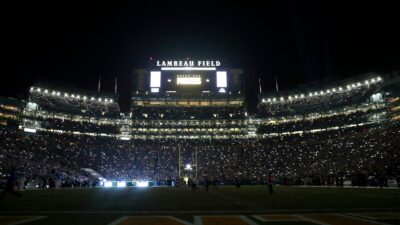For years, Oak Tree Village on Aurora Avenue has offered Seattle a surprisingly intact example of a 1980s shopping center.
Despite a steady churn of tenants and the occasional remodel since the place opened in 1986, the sprawling format — three rows of strip mall businesses, a grocery, a cinema and acres of parking — feels little changed from the days when the original “Top Gun” was on the marquee.
Some of that stuck-in-time character reflects the sluggish pace of redevelopment along Aurora Avenue. But there’s another, stranger force preserving this relic.
Oak Tree Village is one of a handful of businesses on properties leased from the Seattle school district in the 1980s, after falling enrollment led to dozens of school closures.
Back then, these long-term “ground” leases, which let developers build and own surface structures, seemed like savvy public-private partnerships that allowed the district to retain precious land in a growing city while earning needed income.
Some of those partnerships have turned out to be pretty lopsided.
Seattle Public Schools makes just $29,000 a month from Oak Tree Village, which even the district admits is below-market for the land beneath an 8-acre mall with more than 20 retail spaces in one of the country’s wealthiest cities.
The district gets even less from each of three other big ground leases — at Jefferson Square in West Seattle, Wallingford Center in North Seattle and a 49-unit condo complex in Queen Anne — not all of which appear to pay market-rate rent.
All told, Seattle Public Schools, which faces a $94 million budget shortfall, will make just over $900,000 this year on properties that generate many times that in revenues for leaseholders.
On a deeper level, because these ground leases run for a century or even longer, they’ve blunted market forces that might’ve replaced a low-rise artifact like Oak Tree Village with denser, modern development.
Renton-based Oak Tree Plaza Associates, which acquired the mall from the original developer in 1986, has the lease until 2045, with options to extend to 2085. The company declined to comment.
The three other big ground leases have similar, or even later, end dates: One can be extended to 2181.
Fred Podesta, the district’s chief operations officer, sums it up aptly: “We’re kind of freezing these properties in amber.”
*****
Over the last 50 years or so, ground leases have become a popular tool for public entities with major land holdings but limited cash, said Todd Timberlake, former chief real estate officer at the University of Washington.
A university in need of student housing, for example, could lease land to a developer that can do the project with its own capital, Timberlake said.
As important, because the land and any improvements revert to the landowner at the lease’s end, the deals are attractive for school districts like Seattle’s that want to retain property for future needs.
“It’s kind of a win-win,” Timberlake said, of the ground lease concept. “But it comes with some downside.”
Because ground leases usually run for at least 50 years, a poorly crafted deal can mean decades of low returns and other complications.
Ideally, a ground lease gives the landowner an annual income equal to some fraction, generally around 5% to 7%, of the value of the unimproved land.
That payment typically comes via a base rent and, often, some share of the revenue from businesses atop the leased land.
Critically, because land values generally rise, good ground leases include mechanisms such as regular rent increases and property appraisals to ensure that rents keep pace with the land’s market value.
That hasn’t exactly been the story with the district’s big ground leases.
For example, at the West Queen Anne School Condominiums, renovated from an old elementary school, the lease allows rent to be periodically adjusted for fair market value but effectively caps any adjustment at 4% per year. That cap appears to have kept rent from keeping up with the land market.
The last time the district had the condos appraised, in 2009, the district’s monthly payment of $13,824 was found to be less than half the fair market price. Today, the district gets $19,906 a month. The lease runs to 2082 but can be extended 99 years, to 2181.
District officials blame some of these problems on the postrecession climate of the 1980s, which led developers to demand that the district make more concessions.
The original ground leases were “totally tenant driven,” said Lewis Carlson, the district’s real estate supervisor since 2013. “The language … is really in the tenant’s favor, and we’re stuck.”
But district officials note that these deals were negotiated when the district’s priority was to retain property in case enrollment rebounded.
The question of ” ‘Will it make money for us in the meantime?’ seems like … maybe a secondary consideration,” said Podesta.
Even today, Podesta said, the district lacks resources to more actively oversee its remaining ground leases while also operating 104 schools and other properties. On ground leases, he added, “I think it is fair to say we’ve been a bit passive.”
Indeed. The district said it has no recent appraisal for Wallingford Center, an elegant mix of apartments and businesses that opened in 1983 in the old Interlake School.
The district estimates it will receive just $7,900 a month in rent for the center’s ground lease, which would be around 15% less than if the center’s original base rent simply kept up with inflation.
John Teutsch, who manages the Seattle-based partnership that owns the center, said the figure is closer to $17,000 a month. He thinks the district’s estimate may reflect that the partnership inadvertently missed some rent payments from 2022-24, but has since corrected the error. He said no one from the district contacted the partnership about the missing rent.
At the much larger Jefferson Square, on the site of the former Jefferson Elementary School in West Seattle, the ground lease set minimum rent at $8,500 a month, with an unambitious escalator of just 10% every five years.
The district also lacks an appraisal for that property, but this year expects to receive $18,730 a month in revenue. That works out to around 25% less than what the inflation-adjusted base rent would’ve been to lease the land under a mixed-use complex with office space, around 20 businesses, including a Safeway and 451 parking spaces, and a separately owned 78-unit apartment complex with rents currently advertised at $2,449 to $2,699 a month.
Kimco Realty, which manages part of Jefferson Square, declined to comment on the deal. The lease’s seemingly lopsided returns might well have continued through 2083 had Sound Transit not chosen that location for a light rail station.
*****
Oak Tree Village is also not keeping up.
Under the initial lease and subsequent amendments, the district’s payment has shifted from a share of the shopping center’s cash flow, at the start of the lease, to “market land rent for comparable sites” with potential adjustments every five years.
But agreeing on that rent hasn’t been easy. One reason is lease language requiring that any adjustments reflect the parcel’s existing use and the mall owner’s “intended use” for the next five-year period, regardless of any zoning changes that might enable a more profitable use.
After failing to agree on a new rate — at one point in 2006, the district proposed $895,000 a year to the leaseholder’s $315,000, according to district documents — a 2007 arbitration set rent at $350,000, effective 2006.
Since then, the rate has stayed at $350,000, in part, school district officials said, because the property’s use hasn’t changed.
An appraisal the district did in 2023 found the market value of the Oak Tree Village property “as is” and “subject to ground lease” was $10 million. Using a standard 5%-7% rate of return, that would suggest a rental payment of between $500,000 and $700,000 a year.
The district said rent will remain at $350,000 at least through the end of the current five-year adjustment, in 2026, at which point the district will review it for a possible increase.
****
In the near term, the district plans to hire outside experts to see whether its leases could be handled more profitably, or in ways that better serve surrounding communities, Podesta said.
Any changes, however, would be complicated.
Technically, the district can break the leases if it needs the land for “educational purposes.” But that would require paying the ground leaseholders the market value of any improvements, which likely makes it a nonstarter.
And with the district’s recent discussion about closing up to 21 schools, that’s a hard argument to make in any case.
Still, the district is open to ideas from leaseholders. Residents of the West Queen Anne condos, for example, said they’re exploring whether they could simply buy the land from the district.
At Oak Tree Village, district officials say it would be possible for the leaseholder to redevelop the property, which was upzoned in 2019 for five- or seven-story mixed-use buildings.
Carlson, the district’s real estate supervisor, and Podesta say that could make it possible to push for higher rents. But Carlson cautions that any developer interested in a project like that might push for another long-term ground lease, “which we aren’t really interested in doing right now.”
That dilemma is one reason the district is bringing in expertise and “trying to figure out what the best way to move forward with this property is,” he adds.
Around Oak Tree Village, some community members hope the district does find a way to move forward.
Neighbors and tenants say Oak Tree Village got a second wind in December when a Saar’s grocery opened in the long-empty space. And many tenants are quite happy with the wide-open parking, which they say appeals to shoppers.
But some community and housing advocates think such an expanse of asphalt and low-rise buildings is jarringly out of step in a growing 21st-century city and a poor use of a publicly owned parcel on a major transit line.
Groups like Aurora Reimagined Coalition think a denser mix of shops and housing and public amenities, like a plaza, would be a huge boost for a struggling neighborhood.
A decade from now, “that property will be 50 years old,” said Tom Lang, with the coalition. “And if it still looks the way it was designed in 1985, then we have a problem.”



